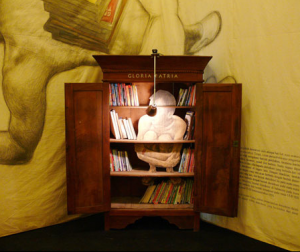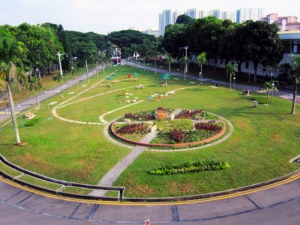In his grotesque installation, My We (2011), Filipino artist, Louie Cordero looks at a spate of violent murders perpetrated on people who sing Frank Sinatra’s My Way in Manilla’s karaoke bars. This is certainly the best story of the 2011 Singapore Biennale, and one with a sly message for the hosts. In a country recognised as the headquarters of Asian economic miracles, My Way could serve as a national anthem, but Cordero reminds us that self-assertiveness is often followed by hubris.
The first Singapore Biennale was held in 2006, the second in 2008. Both shows were masterminded by that smoothest of international celebrity curators, Fumio Nanjo, who surmised that the inhabitants of this materialistic city-state required compelling works of art to jolt them out of their daily grind. Accordingly, the inaugural Biennale took ‘Belief’ as its theme, while its successor explored the concept of ‘Wonder’.
Three, not two years later, the 2011 Biennale goes under the sub-title ‘Open House’, which refers to the traditional burst of hospitality that accompanies Chinese New Year, Deepavali and Hari Raya. It also has that positive, uplifting tone so beloved of the Singaporean government and Singapore Tourism. The phrase projects the image of a nation that opens its doors in friendship to the peoples of the world.
This relentless positivity (and total absence of irony) is deeply at odds with the skepticism that is such a part of the Australian character. Any Australian politician introduced with a loud burst of music that sounds like the theme from Star Wars would be laughed off the podium before they could make a speech. No wonder Singapore’s version of democracy is the envy of every embattled western politician.
The director of this year’s Biennale is local boy, Matthew Ngui, a practicing artist who has spent much of his life in Perth, where he still resides. He has been assisted by Trevor Smith, formerly of Perth, but now working for the Peabody Essex Museum in Salem, USA; and Russell Storer from the Queensland Art Gallery. One imagines that such a strong Australian connection would sit awkwardly with the Singaporean respect for authority and bureaucracy.
If this was not the case, it is partly because Ngui and his colleagues are preoccupied with the idea of artistic “process”. Instead of choosing works that will shock and challenge viewers, they have taken a more cerebral approach, focusing on the circuitous path that leads from idea to execution. This is not necessarily a bad thing, as nothing palls faster than art that sets out to offend its audience, but – to paraphrase a famous critique of action painting – it’s hard to hang a process on a wall.
The show features 161 works by 63 artists from 30 countries, and is spread across three main venues – the Singapore Art Museum (SAM), the National Museum, and the Old Kallang Airport – a complex of three large art deco buildings and a cavernous hangar. To use the language of real estate, Kallang is a renovator’s dream with bags of potential and loads of charm. Unfortunately, the Biennale secured access only about two months’ ago, which means that a massive amount of work had to be done in a short time. The end result is very raw, with bare concrete floors and crudely stripped rooms.
It seems peculiarly un-Singaporean to leave the choice of a major venue to the last minute, a delay that put the curators under huge pressure. As the site is set for re-development, one wonders where the next Biennale will be housed.
The main building at Kallang is a handsome space with a beautiful tiled entrance hall. Inexplicably, after uncovering this art deco splendor, the Biennale allowed German artist, Michael Beutler to fill it with giant-sized rolls of paper on chicken wire, in an installation of pseudo-industrial junk.
The chief difficulty with this work, and with the Biennale in general, is that a lot of effort has been expended for a banal outcome, and banality aspiring to profundity is a recipe for pretention. We have encountered this problem before, in Jonathan Watkins’s Sydney Biennale of 1998, titled “Everyday”. Uninspiring artists from that uninspiring show, such as Ceal Floyer and Beat Streuli, are also included in the current exhibition.
When the hostess at the opening ceremonies kept referring to something called the “Banally”, she was cruelly accurate. There is a form of curatorial brain fever, beyond the reach of medical science, which finds it astonishing that people go to shops, put things in fridges, sit on Ikea furniture, walk in the streets, live in houses, and so on. The curators appreciate artists who share their astonishment, and lean towards works that ‘investigate’ such phenomena. For instance, in parallel videos, we are introduced to the little-known fact that boats go into a harbour, then out of a harbour. In the next room a neon sign says: “Don’t worry”.
The biggest name in this show is probably Martha Rosler, a pioneering feminist video artist from the United States. Her contribution is a garden that stages an oblique riposte to a 2005 project in Helsinki that was never realised. As if this wasn’t obscure enough, the new work is couched as a dialogue with local community groups – perhaps only to persuade them to help move heavy stones. It’s early days, but the so-called garden is a shambles.
While it’s horribly tempting to go on in this vein, the news is not all bad. After the initial forebodings one begins to find works that transcend the dubious attractions of the everyday. One of the most surprising is a tiny cameo by Spanish artist, Rubén Ramos Balsa, who has set a pair of feet stamping around inside a light-bulb. Other pieces that catch the eye at Kallang include that familiar video, Other (2009) by Tracey Moffatt and Gary Hillberg, which brings together moments of inter-ethnic contact from Hollywood films in a wildly entertaining montage; and a reworking of Pier Paolo Pasolini’s 1968 film, Teorema, in which Singaporean, Ming Wong, plays five separate roles spread out over five screens. Ming’s campy amateurism allows us to see Pasolini, hailed as an existentialist visionary in the late sixties, as a supreme poseur.
Another highlight is a video by British artist, Phil Collins that looks at skinhead culture in Malaysia. The strange double-take for the viewer is that these skinheads, with their incongruous bovver boots and braces, would be indistinguishable from Buddhist monks, were they draped in saffron robes.
The best of the Australian contributions came from Gosia Wlodarczak, who set herself a schedule of eight hours a day for twelve days, in the tropical heat, to complete a stream-of-consciousness drawing on windows and glass office partitions. It is a piece that genuinely makes us reflect on process, because this complex, heavily-layered work has been produced with very little intervention from the conscious mind. Everything that went past, everyone that entered the room, every fleeting thought was transcribed before it could be analysed. It is the most impressive single work at Kallang, and easily the most labour-intensive.
Among the stand-out pieces at SAM, top of the line is Candice Breitz’s video installation, Factum (2010), in which the artist has conducted separate interviews with identical twins – and in one case, identical triplets – and juxtaposed the responses. The opinions differ so markedly that we are obliged to revisit all the hackneyed ideas about identical twins and recognise that radically different minds can share the same appearance.
Scarcely less gripping were the drawings made by American artist, Matt Mullican while under hypnosis. In a video we see Mullican moaning and groaning in a trance, while he completes a series of repetitive grids, showing numbers and decorative scrawls. As the subconscious rises to the surface he is transformed into an Outsider artist.
The popular show-stopper of this year’s Biennale is located at Marina Bay, where Japanese artist, Tatzu Nishi has been invited to build one of his ad hoc hotel rooms around the Merlion, that famous white plaster symbol of Singapore. Readers will recall that Nishi recently enclosed the equestrian statues out the front of the Art Gallery of NSW, and the same party trick has been used to good effect in many other parts of the world. Apparently Nishi originally wanted to enclose a bronze statue of Sir Stamford Raffles, that icon of the colonial era. By allowing himself to be persuaded to take on the Merlion, he has created a work with a very different meaning. The piece looks forward rather than back, drawing attention to the amazing Marina Sands casino and convention centre in the distance. In offering up their national symbol to an artist, the Singaporean authorities ask us to take note of their open-mindedness.
Nishi’s installation is a piece of pop theatre, but this could be said about almost everything in Singapore, where signs and slogans strive to create a new version of reality. A lot goes on beneath that shiny facade, but this is barely accessible to the short-term visitor. One may enjoy the hospitality of an open house, but it would be impolite to stay too long or ask difficult questions. In a world reconfigured for the needs of tourists and consumers, the arrangement works just fine.
Published for The Sydney Morning Herald, March 19, 2011





